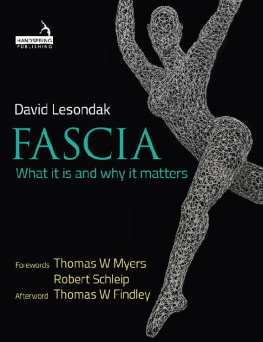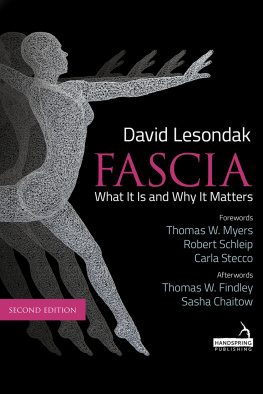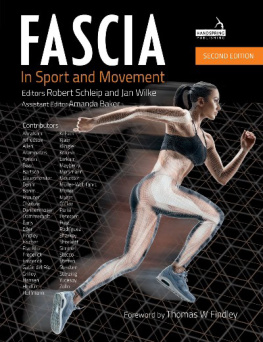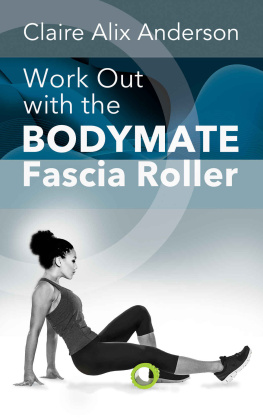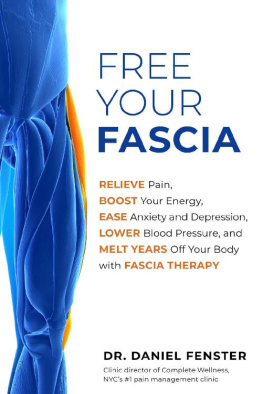FASCIA
What it is and why it matters

HANDSPRING PUBLISHING LIMITED
The Old Manse, Fountainhall,
Pencaitland, East Lothian
EH34 5EY, Scotland
Tel: +44 1875 341 859
Website: www.handspringpublishing.com
First published 2017 in the United Kingdom by Handspring Publishing
Copyright Handspring Publishing Ltd 2017
All rights reserved. No parts of this publication may be reproduced or transmitted in any form or by any means, electronic or mechanical, including photocopying, recording, or any information storage and retrieval system, without either the prior written permission of the publisher or a licence permitting restricted copying in the United Kingdom issued by the Copyright Licensing Agency Ltd, Saffron House, 610 Kirby Street, London EC1N 8TS.
The right of David Lesondak to be identified as the Author of this text has been asserted in accordance with the Copyright, Designs and Patents Acts 1988.
ISBN 978-1-909141-55-1
British Library Cataloguing in Publication Data
A catalogue record for this book is available from the British Library
Library of Congress Cataloguing in Publication Data
A catalog record for this book is available from the Library of Congress
Notice
Neither the Publisher nor the Authors assume any responsibility for any loss or injury and/or damage to persons or property arising out of or relating to any use of the material contained in this book. It is the responsibility of the treating practitioner, relying on independent expertise and knowledge of the patient, to determine the best treatment and method of application for the patient.
All reasonable efforts have been made to obtain copyright clearance for illustrations in the book for which the authors or publishers do not own the rights. If you believe that one of your illustrations has been used without such clearance please contact the publishers and we will ensure that appropriate credit is given in the next reprint.
Commissioning Editor Sarena Wolfaard
Project Manager Morven Dean
Copy Editor Sally Davies
Cover photo Robert Strovers www.robertstrovers.com
Sculpture on cover Michael Gard - www.michaelgard.com
Designer Bruce Hogarth www.kinesis-creative.com
Indexer Aptara, India
Typesetter Thomson Digital, India
Printer Finidr, Czech Republic
The
Publishers
policy is to use
paper manufactured
from sustainable forests

CONTENTS
by Tom Myers
by Robert Schleip
by Tom W Findley
Eric McLuhan, the son of the great media expert Marshall McLuhan, taught me to speed read in 1970 a talent I have been grateful for ever since. But his opening line was: Would you rather spend forty-five minutes reading a summary of the book or in conversation with the author? Everyone answers In conversation with the author.
I can personally assure you that David Lesondak is a brilliant and engaging conversationalist. This book is exactly like having a talk with him his personal whimsical style and humor shine through, the wide variety of his interests are in evidence at every turn. David has a way of explaining complex ideas in understandable terms without dulling the scientific edge or cheapening the argument.
You can take this book home with you and enjoy it all at once as a great big meal, or snack on it in pieces either way you will be assured of tasty and nutritious food for your mind. It has the additional benefit of being fresh the scientific information on fascia is accurate and up to date.
It has been my pleasure to know David for over a decade as a student, colleague, and teacher, and this book is an absolutely quintessential expression of his dedication to accuracy, his panoramic scope, and his infectious enthusiasm for the living fabric of the body.
Tom Myers
Clarks Cove, Maine
June 2017
When I invited David to use his video skills to document the first Fascia Summer School in 2010 I had no idea what I was in for. Neither, I think, did he.
Though we had met several years previously, it was over the ensuing seven years that every time I turned around at a major conference David was there; behind his cameras, capturing all the moments and later meticulously editing the lectures for maximum clarity.
I came to realize there was a very keen mind behind that camera, putting theories and ideas together in some very unique ways over the many conversations and teaching opportunities that we have shared. This was very apparent in his many intelligent questions, with which he interspersed his frequent personal interviews with our keynote presenters, and also in his own active input in the many discussions that surround an effective scientific meeting. In fact, I was so much impressed by Davids personal knowledge of the fascia research field and his own ideas in this area that we gave him the opportunity to lecture himself at our bi-annual Fascia Research Summer School at Ulm University. However, I was not prepared for the mastery and brilliance with which he filled that slot and impressed even me.
So too, I suspect, he will surprise you as you read his book. Whether you are new to the wonderful world of fascia or an old-timer like myself, you will find ideas, images, and impeccably explained science, written in a way that is both illuminating and memorably entertaining. At the same time, this book will serve as a valuable reference with which to dive deeper into study as you see fit.
This is a true masterpiece. It takes the reader on an entertaining journey into fascia land from both a lay persons as well as a clinicians perspective. I will definitely ask David for permission to use some of his elegant and impressive illustrations, concepts, and creative analogies in my own teaching and writing in the future. We will also make sure David is no longer solely behind the cameras at our international events but in front of them as well. What he has to share it truly too good to miss.
Perhaps because of my own professional journey, one of my favorite things is watching a clinician make the journey from therapy land into science land. When I first met David, I thought he might be one of those clinicians. But never did I expect that 10 years later I would be reading a book like this.
I cannot wait to see what he does in the next 10 years. I will be first in line.
Robert Schleip
Munich, Germany
June 2017
I should write a book one day, how many of us think that? Most of us, Ill wager myself included.
Many people tell me what an accomplishment it is that I have actually done just that. Honestly, it does not feel that way from the inside.
It was a thorough pleasure. Of course there were moments moments where it felt as if what I wanted to say was somehow bigger than my brain could contain. And then those moments had to be funneled through my brain mouth and down into finger words. Writing is a mechanical process. It is also a cranial, thinking process. It is both/and somewhat like fascia.
So as I think about how this book came to be I keep coming back to one specific thing, and three people that I would like to blame.
What was the specific thing? I was there.
My quest to find more reliable outcomes for my patients, those who entrusted me with being the custodian and wayfinder for the way out of their chronic pain, led me to the world of fascia and that world turned out to be a whole inner universe.

